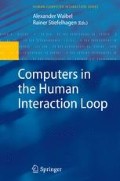Abstract
This chapter will discuss the Connector service. The goal was to build a mobile communication system that could help people better manage the risk of untimely interruptions in an always-on world, where we can reach each other anytime and anyplace. In an iterative process of design, we have developed technologies that intelligently and nondisruptively integrate into human communication processes.
Access this chapter
Tax calculation will be finalised at checkout
Purchases are for personal use only
Preview
Unable to display preview. Download preview PDF.
References
P. Adamczyk and B. Bailey. If not now, when?: the effects of interruption at different moments within task execution. Proceedings of the SIGCHI conference on Human factors in computing systems, pages 271–278, 2004.
D. Avrahami and S. Hudson. QnA: augmenting an instant messaging client to balance user responsiveness and performance. Proceedings of the 2004 ACM conference on Computer supported cooperative work, pages 515–518, 2004.
H. Clark. Using Language. Cambridge University Press, 1996.
M. Csikszentmihalyi. Flow: The Psychology of Optimal Experience. Harper Perennial, New York, Mar. 1991.
M. Danninger. Intelligently Connecting People – Facilitating Socially Appropriate Communication in Mobile and Office Environments. PhD thesis, Universität Karlsruhe (TH), 2008.
M. Danninger, G. Flaherty, K. Bernardin, H. K. Ekenel, T. Köhler, R. Malkin, R. Stiefelhagen, and A.Waibel. The connector: facilitating context-aware communication. In ICMI ’05: Proceedings of the 7th international conference on Multimodal interfaces, pages 69– 75, New York, NY, 2005. ACM Press.
M. Danninger, E. Robles, L. Takayama, Q.Wang, T. Kluge, R. Stiefelhagen, and C. Nass. The connector service - predicting availability in mobile contexts. In MLMI, LNCS 4299, pages 129–141. Springer, 2006.
M. Danninger, L. Takayama, Q.Wang, C. Schultz, J. Beringer, P. Hofmann, F. James, and C. Nass. Can you talk or only touch-talk? a voip-based phone feature for quick, quiet, and private communication. In ICMI ’07: Proceedings of the 9th international conference on Multimodal interfaces, New York, NY, 2007. ACM Press.
T. Erickson and W. A. Kellogg. Social translucence: an approach to designing systems that support social processes. ACM Transactions on Computer-Human Interaction, 7(1):59–83, 2000.
J. Fogarty, S. E. Hudson, C. G. Atkeson, D. Avrahami, J. Forlizzi, S. Kiesler, J. C. Lee, and J. Yang. Predicting human interruptibility with sensors. ACM Transactions on Computer - Human Interaction, 12(1):119–146, 2005.
J. M. Hudson, J. Christensen, W. A. Kellogg, and T. Erickson. “i’d be overwhelmed, but it’s just one more thing to do”: availability and interruption in research management. In CHI ’02: Proceedings of the SIGCHI conference on Human factors in computing systems, pages 97–104, New York, NY, 2002. ACM Press.
M. Ito. Mobile Phones, Japanese Youth, and the Re-Placement of Social Contact. Annual Meeting of the Society for Social Studies of Science, 2001.
R. Kubey, R. Larson, and M. Csikszentmihalyi. Experience sampling method applications to communication research questions. Journal of communication, 46(2):99–120, 1996.
S. Love and M. Perry. Dealing with mobile conversations in public places: some implications for the design of socially intrusive technologies. In CHI ’04: CHI ’04 extended abstracts on Human factors in computing systems, pages 1195–1198, New York, NY, 2004. ACM Press.
R. Malkin. Machine listening for context-aware computing. PhD thesis, Carnegie Mellon University, 2006.
A. Monk, J. Carroll, S. Parker, and M. Blythe. Why are mobile phones annoying? Behavioral Information Technology, 23(1):33–41, 2004.
C. Nass and S. Brave. Wired for Speech: How Voice Activates and Advances the Human - Computer Relationship. The MIT Press, 2005.
L. Palen, M. Salzman, and E. Youngs. Going wireless: behavior & practice of new mobile phone users. Proceedings of the 2000 ACM conference on Computer supported cooperative work, pages 201–210, 2000.
N. Wiener. The Human Use of Human Beings: Cybernetics and Society. Da Capo Press, 1988.
Author information
Authors and Affiliations
Editor information
Editors and Affiliations
Rights and permissions
Copyright information
© 2009 Springer-Verlag London Limited
About this chapter
Cite this chapter
Danninger, M., Robles, E., Sukumaran, A., Nass, C. (2009). The Connector Service: Representing Availability for Mobile Communication. In: Waibel, A., Stiefelhagen, R. (eds) Computers in the Human Interaction Loop. Human–Computer Interaction Series. Springer, London. https://doi.org/10.1007/978-1-84882-054-8_19
Download citation
DOI: https://doi.org/10.1007/978-1-84882-054-8_19
Publisher Name: Springer, London
Print ISBN: 978-1-84882-053-1
Online ISBN: 978-1-84882-054-8
eBook Packages: Computer ScienceComputer Science (R0)

